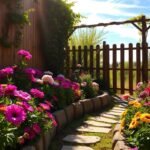Did you know your kitchen scraps could become tomorrow’s thriving garden? With a little imagination, ordinary objects like coffee tins, plastic crates, or wooden boxes can get new life as unique planters. This approach lets you grow herbs, flowers, or veggies without breaking the bank.
Repurposing materials isn’t just about saving money – it’s a chance to add personality to your space. Old olive oil cans become rustic herb pots, while milk crates transform into modular veggie beds. The key? Ensure your chosen container has enough room for roots and proper drainage holes.
You’ll discover how wine boxes make perfect homes for trailing flowers, and colanders become quirky strawberry planters. Our guide to creative container gardening hacks shows how to adapt these finds for different plants. We’ll help you avoid common pitfalls while turning forgotten items into functional art.
Whether you’re growing on a balcony or backyard, this method reduces waste and sparks joy. Let’s explore how to match plants with unconventional pots – because great gardens begin with clever beginnings!
Discovering the Joy of Upcycling for Your Garden
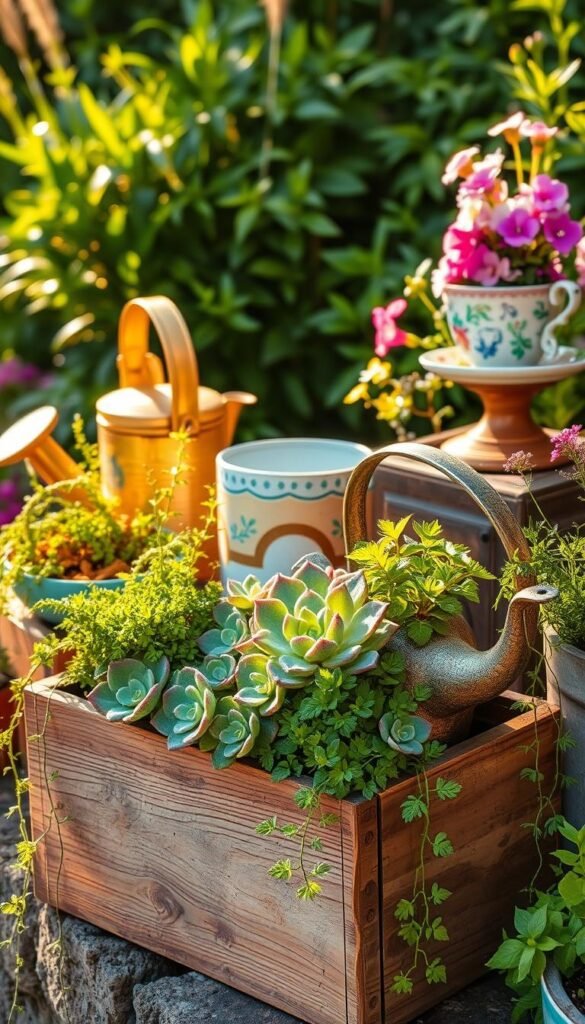
Imagine turning yesterday’s trash into today’s lush greenery – that’s the magic of giving old objects new purpose. Repurposing materials cuts waste while adding character to your garden, creating a space that’s uniquely yours.
Why Repurposing Works Wonders
Every reused item keeps plastic and cardboard out of landfills. A yogurt cup becomes a seed starter. An old colander transforms into a strawberry planter with natural drainage holes. Even kitchen scraps like eggshells can nurture seedlings!
Urban gardener Mia turned rain boots into thriving herb pots. “Drilling holes in the soles solved drainage,” she says. “Now my rosemary grows better than in store-bought pots!”
Stories That Spark Creativity
In Brooklyn, a community gardening group grows tomatoes in repainted filing cabinets. One member even uses vintage teapots for succulents. Their secret? Matching plants to container size – shallow roots go in pizza boxes, deep-rooted veggies in laundry baskets.
Pro tip: Test your ideas with cheap or free materials first. Cardboard egg cartons work beautifully for starting seeds, while plastic takeout containers make mini greenhouses. For more eco-friendly container gardening strategies, explore how to balance functionality with flair!
Everyday Items You Can Turn into Garden Containers
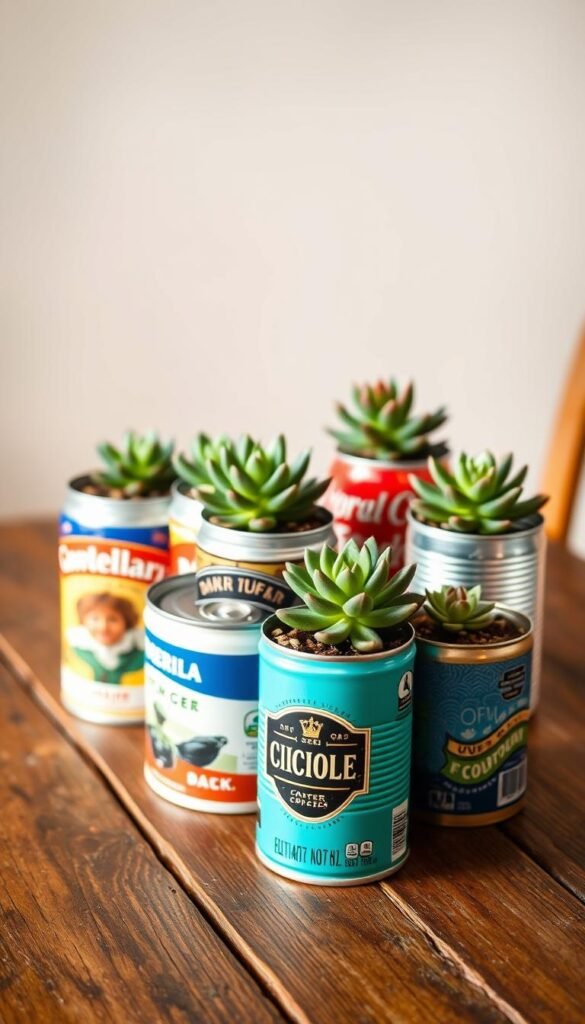
Empty cans and crates might be the garden heroes you never expected. With a few tweaks, these ordinary kitchen staples become stylish homes for herbs, flowers, or veggies. Let’s dive into three versatile options that blend practicality with personality.
Coffee and Olive Oil Cans as Mini Planters
Metal tins from coffee or olive oil make charming planters. Start by drilling 4-5 holes in the bottom for drainage. Sand sharp edges, then paint the exterior with outdoor-safe colors. Fill with soil mixed with compost for herbs like basil or mint. These compact containers fit perfectly on windowsills or balcony railings.
Plastic Milk Crates and Wine Boxes in Action
Turn milk crates into modular veggie beds. Line them with landscape fabric to hold soil while allowing airflow. Stack multiple crates vertically for strawberries or lettuce. Wooden wine boxes need a food-safe oil coat to withstand moisture. Their shallow depth suits microgreens or succulents.
| Container Type | Prep Steps | Best Plants | Pro Tip |
|---|---|---|---|
| Coffee Cans | Drill holes, sand edges | Herbs, small flowers | Use chalk paint for labels |
| Milk Crates | Add fabric liner | Leafy greens, strawberries | Group crates for visual impact |
| Wine Boxes | Apply tung oil | Microgreens, trailing plants | Elevate to prevent rot |
Always test drainage by watering your container before planting. A 1-inch gravel layer at the base helps heavy plastic crates stay stable. Rotate plants seasonally to keep your upcycled garden thriving year-round!
Creative Seed Starting Solutions from Kitchen & Household Waste
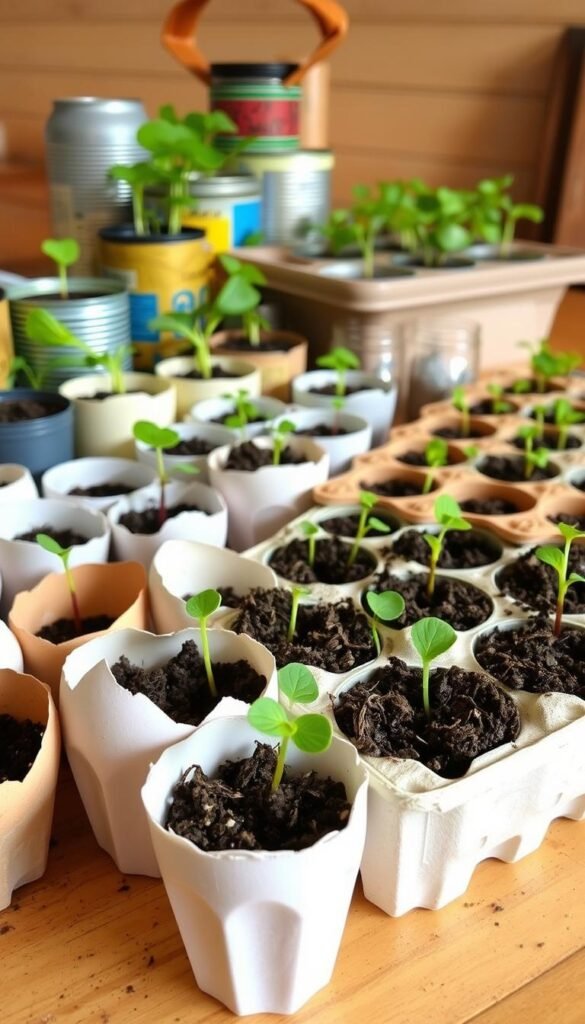
Your morning coffee grounds and take-out boxes hold hidden potential. Transform everyday trash into tiny plant nurseries using simple, earth-friendly methods. These projects cut costs, reduce clutter, and give seedlings a healthy head start.
Biodegradable Pots That Feed Your Soil
Roll old newspapers into seedling cups – no glue needed! Dampen strips, wrap them around a jar, and fold the base. These homes decompose when planted, enriching your garden bed. Cardboard egg cartons work similarly: fill each cup with soil, plant seeds, and tear apart sections when transplanting.
Eggshells add calcium as they break down. Crack eggs near the top, rinse shells, and poke a drainage hole with a needle. Fill with potting mix and sow basil or chives. When roots emerge, crush the shell and plant it directly!
Clear Containers for Smarter Growing
Turn plastic salad boxes into mini greenhouses. Wash them thoroughly, drill 3-4 holes in the lid for airflow, and place seedlings inside. The transparent top traps humidity while letting light through. For taller plants, cut water bottles horizontally – use the bottom half as a pot and the top as a humidity dome.
| Material | Preparation | Best Seeds | Bonus Benefit |
|---|---|---|---|
| Newspaper | Roll into 3″ tubes | Peppers, tomatoes | Improves soil structure |
| Eggshells | Rinse & puncture | Herbs, microgreens | Adds nutrients |
| Take-out containers | Drill ventilation holes | Lettuce, flowers | Reusable for years |
Keep starter pots moist but not soggy. Place them near a sunny window or under grow lights. Rotate containers daily for even growth. These diy solutions prove that great gardens begin with humble items!
Innovative Rain Gutter and Outdoor Container Ideas

What if your home’s rainwater system could double as a vibrant garden feature? Discarded gutters offer endless possibilities for growing plants in tight spaces. Their long, narrow shape makes them ideal for herbs, succulents, or cascading flowers that thrive in shallow soil.
From Roofs to Window Displays
Turn metal or plastic gutters into eye-catching window planters. Start by drilling ¼-inch holes every 6 inches along the bottom for proper drainage. Attach end caps with waterproof sealant, then spray-paint the exterior in bold colors. Mount them beneath windows using sturdy brackets.
These slim planters work perfectly for lettuce mixes or creeping thyme. Their compact design saves space while adding vertical interest. Rotate crops seasonally – try pansies in spring or ornamental kale in fall.
Mix Materials for Custom Creations
Plastic gutters are lightweight and easy to cut, while metal versions offer rustic charm. Line plastic sections with coconut coir to retain moisture, or let metal develop a natural patina. Connect multiple pieces into zigzag patterns along fences for dramatic effects.
| Material | Best For | Prep Tip |
|---|---|---|
| Plastic | Balcony gardens | Use UV-resistant paint |
| Aluminum | Edible flowers | Add rubber washers to prevent rust |
| Copper | Succulent displays | Let natural oxidation shine |
Salvage old gutters from renovation sites or thrift stores. Pair them with DIY trellises made from ladder rungs for a cohesive look. This approach turns functional materials into conversation-starting garden art!
DIY Upcycled Planters for Every Season
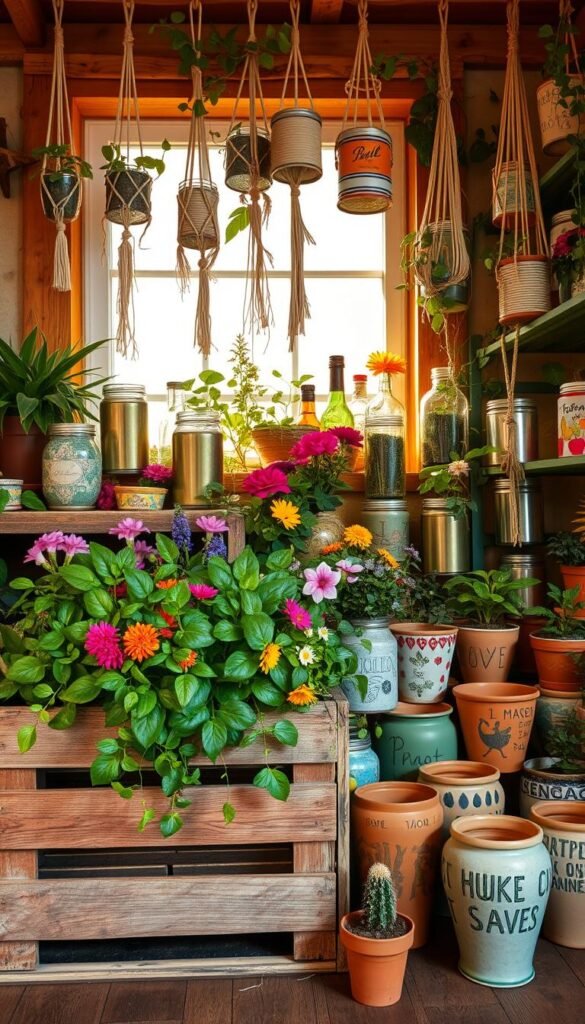
As seasons shift, so do opportunities to reimagine everyday objects as thriving homes for your greenery. Match your garden projects to nature’s calendar using materials that suit each period’s unique needs – from spring seedlings to winter-hardy displays.
Seasonal Materials and Planting Tips
Early spring calls for temporary starters. Cut milk jugs horizontally to create mini greenhouses for lettuce seeds. The transparent plastic protects sprouts from frost while letting sunlight through. Come summer, repaint metal buckets as tomato pots – their depth supports strong roots.
| Season | Materials | Plants | Care Tips |
|---|---|---|---|
| Spring | Egg cartons, yogurt cups | Peppers, marigolds | Use warm water to prevent shock |
| Summer | Wine barrels, storage bins | Zucchini, petunias | Add mulch for water retention |
| Fall | Wooden crates, tires | Pansies, kale | Elevate containers to avoid rot |
| Winter | Insulated coolers, tin cans | Evergreens, ornamental cabbage | Limit watering in freezing temps |
Autumn is perfect for shallow-rooted crops. Line woven baskets with landscape fabric to plant kale or spinach. When winter arrives, wrap old sweaters around ceramic pots to insulate dormant herbs. Rotate your ideas yearly – last season’s toolbox could become this year’s succulent showcase!
Always drill extra drainage holes before frost sets in. Group flowers and veggies with similar sunlight needs. With smart prep, your reinvented containers will evolve beautifully with your gardening goals.
Budget-Friendly Containers: Upcycling Household Items for Gardening
Hidden treasures for your garden might already be sitting in your garage or pantry. The key lies in matching your plant’s needs with the right repurposed object – ensuring both thrive without draining your wallet.
Selecting the Right Container for Your Plants
Start by sizing up your plant’s roots. Shallow-rooted herbs like thyme thrive in asparagus crates, while tomatoes need deeper pots. Check for existing drainage holes – if none exist, drill 3-4 quarter-inch openings. Line porous materials like baskets with burlap to retain soil.
Old toolboxes make excellent succulent homes, and cracked ceramic bowls become colorful planters for annual flowers. Test containers with water before planting – if puddles linger after 30 minutes, add more holes.
Budget Considerations and Material Durability
Focus on free or low-cost items first. Milk jugs last 2-3 seasons when painted for UV protection. Wooden crates need weatherproofing but offer rustic charm. Metal tins rust faster but work well for short-term plants.
| Material | Lifespan | Best Uses |
|---|---|---|
| Plastic | 3-5 years | Vegetables, herbs |
| Wood | 2-3 seasons | Flowers, shallow crops |
| Metal | 1-2 seasons | Succulents, annuals |
Save time in spring by prepping containers during winter. Wash and drill holes in old buckets now, then fill with quality potting mix later. Rotate water-heavy plants between materials to extend your garden’s life.
Exploring Non-Traditional Recyclable Items for Unique Planters

Your garden’s next showstopper might be gathering dust in your attic. Beyond jars and crates lies a world of forgotten objects waiting to become living art. Let’s uncover how unusual finds can redefine your green spaces.
Breathing New Life Into Unexpected Treasures
A vintage wagon becomes a mobile flower bed when lined with burlap and filled with soil. Drill holes in its wooden bottom for drainage, then paint the wheels for a pop of color. Plant trailing petunias to spill over the sides like confetti.
Old farmhouse sinks make striking succulent displays. Scrub away rust, apply waterproof sealant, and layer gravel at the base. Their deep basins let you mix tall cacti with low-growing sedums. Place one by your front door as a welcoming centerpiece.
| Item | Prep Steps | Best Plants | Design Tip |
|---|---|---|---|
| Antique Chamber Pot | Clean with vinegar, add drainage holes | Ferns, ivy | Hang from porch beams |
| Retired Wheelbarrow | Line with landscape fabric | Cherry tomatoes, herbs | Angle on bricks for drainage |
| Vintage Suitcase | Seal seams, drill holes | Wildflowers, moss | Stack as tiered display |
Wooden wine barrels cut in half create rustic citrus tree planters. Their sturdiness supports heavy fruit loads. For smaller spaces, mount colanders on fences as strawberry planters – their holes offer built-in airflow.
Check your basement for potential candidates. A cracked birdbath becomes a fairy garden when filled with thyme and miniature ornaments. Remember: any container holding soil needs drainage and weather-resistant materials.
What unique items could transform your home’s outdoor aesthetic? That chipped teapot? Perfect for alpines. The broken ladder? Ideal for hanging mason jar herb gardens. Your creativity is the only limit!
Expert Tips for Maximizing Your Container Gardening Success
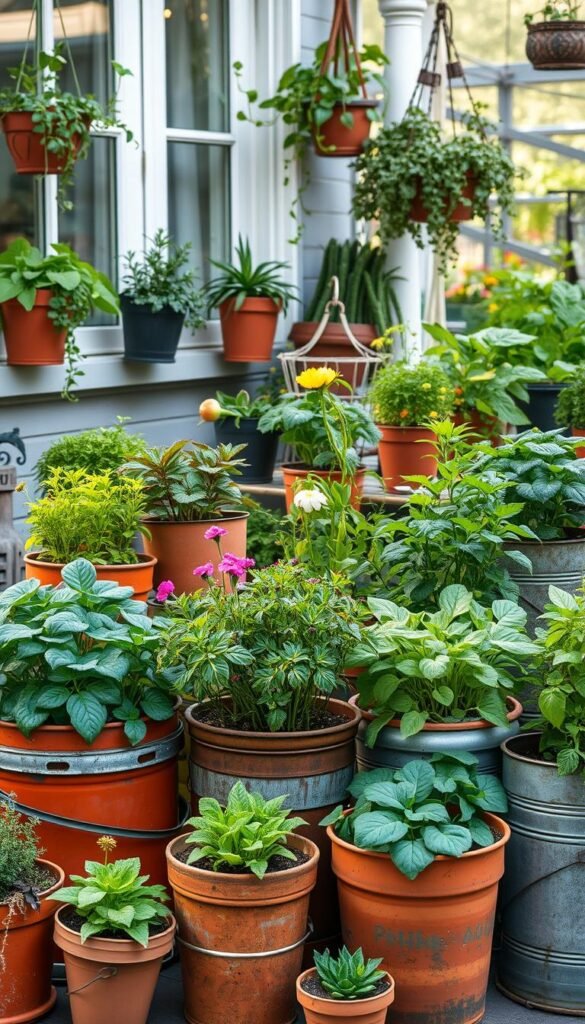
Even the most creative gardens face challenges if basic needs aren’t met. Let’s explore professional strategies to keep your plants thriving while extending your container’s lifespan.
Managing Drainage, Soil, and Watering Needs
Proper drainage starts with hole placement. Drill ¼-inch holes every 6 inches across the bottom and sides for excess water escape. Line containers with coffee filters to prevent soil loss. Mix 2 parts potting soil with 1 part perlite for optimal moisture balance.
Check soil daily by inserting a finger up to the second knuckle. If dry, water deeply until it flows from the holes. Group plants with similar needs – succulents and herbs rarely share thirst levels!
| Container Material | Watering Frequency | Soil Mix Ratio |
|---|---|---|
| Plastic | Every 2-3 days | 60% soil, 30% compost, 10% sand |
| Wood | Daily in summer | 50% soil, 40% coco coir, 10% bark |
| Metal | Every 4 days | 70% soil, 20% vermiculite, 10% peat |
Long-Term Maintenance and Repurposing Strategies
Inspect containers each spring for cracks or rust. Sand wooden boxes and apply linseed oil to prevent rot. Refresh soil annually by replacing the top 3 inches with compost-enriched mix.
Rotate plants between containers every 2-3 years to prevent disease buildup. For pest control, spray neem oil weekly and remove dead leaves promptly. Share your ideas in local gardening groups – a neighbor’s cracked birdbath might become your next strawberry planter!
New to gardening? Master the container gardening basics before experimenting with advanced techniques. Small adjustments today yield lush results tomorrow!
Reflections on Your Upcycled Garden Journey
Transforming everyday objects into vibrant plant homes reshapes how you view both waste and beauty. Through creative reuse, you’ve discovered how drainage holes in coffee cans nurture herbs and how plastic crates become modular veggie beds. Each project reduces clutter while adding life to your garden.
From eggshell seed starters to gutter planters, you’ve explored countless ways to grow without excess spending. Remember the joy of watching plants thrive in repurposed materials? That satisfaction grows with every bloom and harvest.
Share your successes – whether it’s tomatoes in rain boots or succulents in teacups. Your ideas inspire others to see potential in forgotten containers. Keep testing soil mixes, adjusting water routines, and drilling those crucial holes in the bottom.
What’s next? Maybe turn an old ladder into vertical planters or transform cracked ceramics into mosaic homes for flowers. Every season brings fresh opportunities to innovate. Keep growing, keep reimagining – your garden journey’s just beginning!






